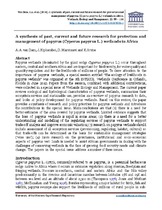| dc.contributor.author | van Dam, A. A. | |
| dc.contributor.author | Kipkemboi, J. | |
| dc.contributor.author | Mazvimavi, Dominic | |
| dc.contributor.author | Irvine, K. | |
| dc.date.accessioned | 2017-12-04T13:26:15Z | |
| dc.date.available | 2017-12-04T13:26:15Z | |
| dc.date.issued | 2014 | |
| dc.identifier.citation | Van Dam, A.A. et al. (2014). A synthesis of past, current and future research for protection and management of papyrus (Cyperus papyrus L.) wetlands in Africa. Wetlands, Ecology and Management, 22: 99 – 114 | en_US |
| dc.identifier.issn | 0923-4861 | |
| dc.identifier.uri | http://dx.doi.org/10.1007/s11273-013-9335-1 | |
| dc.identifier.uri | http://hdl.handle.net/10566/3295 | |
| dc.description.abstract | Papyrus wetlands (dominated by the giant
sedge Cyperus papyrus L.) occur throughout eastern,
central and southern Africa and are important for
biodiversity, for water quality and quantity regulation
and for the livelihoods of millions of people. To draw
attention to the importance of papyrus wetlands, a
special session entitled ‘‘The ecology of livelihoods in
papyrus wetlands’’ was organized at the 9th INTECOL
Wetlands Conference in Orlando, Florida in June
2012. Papers from the session, combined with additional
contributions, were collected in a special issue
of Wetlands Ecology and Management. The current
paper reviews ecological and hydrological characteristics
of papyrus wetlands, summarizes their ecosystem
services and sustainable use, provides an
overview of papyrus research to date, and looks at
policy development for papyrus wetlands. Based on
this review, the paper provides a synthesis of research
and policy priorities for papyrus wetlands and introduces
the contributions in the special issue. Main
conclusions are that (1) there is a need for better
estimates of the area covered by papyrus wetlands.
Limited evidence suggests that the loss of papyrus
wetlands is rapid in some areas; (2) there is a need for a
better understanding and modelling of the regulating
services of papyrus wetlands to support trade-off
analysis and improve economic valuation; (3) research
on papyrus wetlands should include assessment of all
ecosystem services (provisioning, regulating, habitat,
cultural) so that trade-offs can be determined as the
basis for sustainable management strategies (‘wise
use’); (4) more research on the governance, institutional
and socio-economic aspects of papyrus wetlands
is needed to assist African governments in
dealing with the challenges of conserving wetlands in
the face of growing food security needs and climate
change. The papers in the special issue address a
number of these issues. | en_US |
| dc.language.iso | en | en_US |
| dc.publisher | Springer Verlag | en_US |
| dc.rights | This is the author-version of the article published online at: http://dx.doi.org/10.1007/s11273-013-9335-1 | |
| dc.subject | Papyrus | en_US |
| dc.subject | Wetlands | en_US |
| dc.subject | Africa | en_US |
| dc.subject | Ecosystem services | en_US |
| dc.subject | Water governance | en_US |
| dc.subject | Wise use of wetlands | en_US |
| dc.title | A synthesis of past, current and future research for protection and management of papyrus (Cyperus papyrus L.) wetlands in Africa | en_US |
| dc.type | Article | en_US |
| dc.privacy.showsubmitter | FALSE | |
| dc.status.ispeerreviewed | TRUE | |

